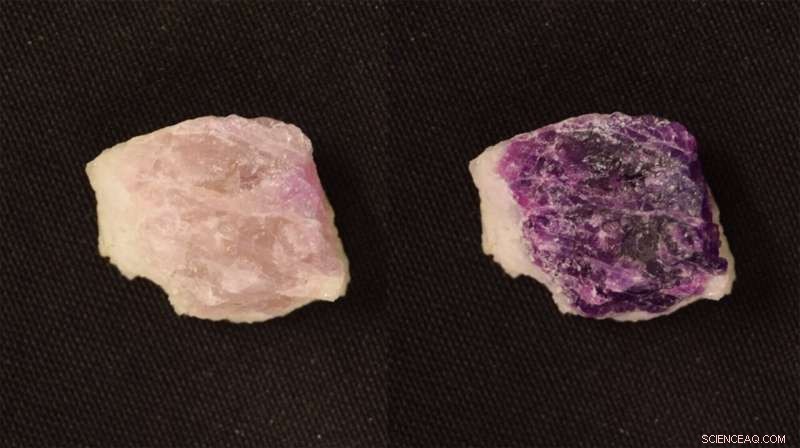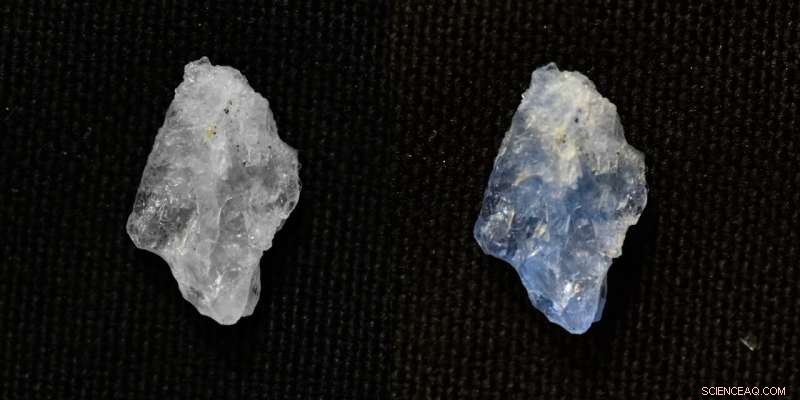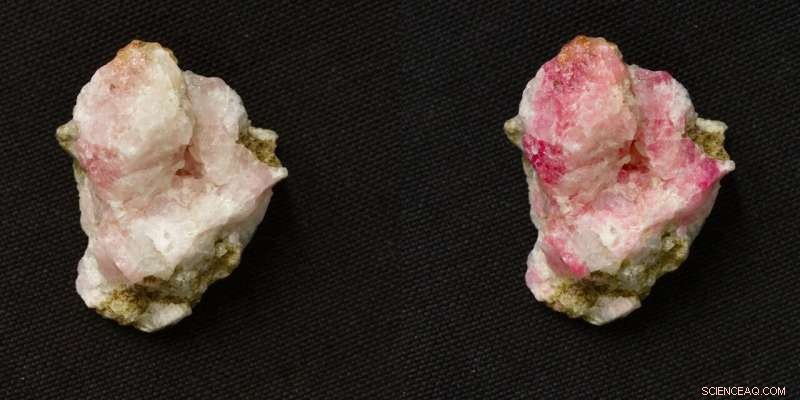
Hackmanite se vuelve púrpura bajo la radiación ultravioleta, y el color se desvanece de nuevo a blanco en unos minutos bajo la luz blanca normal. Esta muestra es de Groenlandia. Crédito:Mika Lastusaari
Mientras investigaban la hackmanita, los investigadores descubrieron que puede cambiar de color al exponerse a la radiación UV repetidamente sin desgastarse. Los resultados muestran que la hackmanita económica, que es fácil de sintetizar, también tiene una alta durabilidad y múltiples aplicaciones.
Un grupo de investigación de la Universidad de Turku, Finlandia, ha estado investigando y desarrollando las propiedades de la hackmanita durante casi una década. Se han desarrollado aplicaciones como el monitoreo UV personal y las imágenes de rayos X basadas en la capacidad de hackmanite para cambiar de color.
Hackmanite cambia su color de blanco a púrpura bajo la radiación UV y eventualmente vuelve a ser blanco si no hay UV presente. Las características estructurales que permiten tales cambios repetidos hasta ahora no han sido claras. Ahora, al investigar tres minerales naturales:hackmanita, tugtupita y escapolita, los investigadores han encontrado la respuesta.
Estos minerales que cambian de color son materiales naturales inorgánicos, pero también existen compuestos orgánicos, los hidrocarburos, que pueden cambiar de color de forma reversible debido a la exposición a la radiación. Estos hidrocarburos, sin embargo, solo pueden cambiar de color unas pocas veces antes de que su estructura molecular se rompa. Esto se debe a que el cambio de color implica un cambio drástico en la estructura, y sufrir este cambio repetidamente eventualmente rompe la molécula.
"En esta investigación, descubrimos por primera vez que en realidad también hay un cambio estructural involucrado en el proceso de cambio de color. Cuando el color cambia, los átomos de sodio en la estructura se alejan relativamente de sus lugares habituales y luego regresan Esto se puede llamar 'respiración estructural' y no destruye la estructura incluso si se repite una gran cantidad de veces", informa el profesor Mika Lastusaari del Departamento de Química de la Universidad de Turku, Finlandia.

La escapolita blanca se vuelve azul bajo la radiación ultravioleta. La coloración y la reversión a blanco después de la eliminación de la fuente de UV toman solo unos segundos, porque los átomos en la estructura se mueven distancias cortas. La escapolita es un mineral bastante común. Esta muestra es de Afganistán. Crédito:Sami Vuori
Los investigadores demostraron que la capacidad de la hackmanita para alternar entre las formas blanca y morada es altamente repetible.
Según el profesor Lastusaari, la durabilidad se debe a la fuerte estructura general tridimensional similar a una jaula de estos minerales, que es similar a la que se encuentra en las zeolitas. En los detergentes, por ejemplo, la estructura en forma de jaula permite que la zeolita elimine el magnesio y el calcio del agua al unirlos firmemente dentro de los poros de la jaula.
"In these color-changing minerals, all processes associated with the color change occur inside the pores of the zeolitic cage where the sodium and chlorine atoms reside. That is, the cage-like structure allows atomic movement inside the cage while keeping the cage itself intact. This is why minerals can change color and revert back to their original color practically indefinitely," Doctoral Researcher Sami Vuori explains.
Previously, it has been known that scapolite changes color much faster than hackmanite, whereas tugtupite's changes are much slower.
"Based on the results of this work, we found out that the speed of the color change correlates with the distance that the sodium atoms move. These observations are important for future material development, because now we know what is required from the host structure to allow the control and tailoring of the color change properties," says Doctoral Researcher Hannah Byron.
"There were no characterization methods available for the research on color changing minerals, which is why we have developed new methods by ourselves. However, it is difficult to interpret the results unambiguously based on experimental data alone. In fact, we could not have reached the present conclusions without strong support from theoretical calculations, since only the combination of experimental and computational data shows the whole picture. We owe a great many thanks to our collaborator Professor Tangui Le Bahers and his group, who have developed and advanced suitable computational methods to such detail and accuracy that would not have been possible just a few years ago," says Lastusaari.

Tugtupite is a rare mineral, which turns pink when exposed to UV radiation. The return back to white takes several hours, because it requires large atomic movements. This sample is from Greenland. Credit:Sami Vuori
Hackmanite has amazing potential for applications
The Intelligent Materials Research Group at the Department of Chemistry of the University of Turku, led by Lastusaari, has long conducted pioneering research on materials with light and color-related properties, especially on hackmanite. They are currently exploring numerous applications for hackmanite, such as possibly replacing LEDs and other light bulbs with the natural mineral and using it in X-ray imaging.
One of the most interesting avenues that the researchers are currently exploring is a hackmanite-based dosimeter and passive detectors for the International Space Station, intended to be used to measure the radiation dose uptake of materials during space flights.
"The strength of hackmanite's color depends on how much UV radiation it is exposed to, which means that the material can be used, for example, to determine the UV index of Sun's radiation. The hackmanite that will be tested on the space station will be used in a similar fashion, but this property can also be used in everyday applications. We have for example already developed a mobile phone application for measuring UV radiation that can be used by anyone," explains Sami Vuori.
The paper was published in June in the PNAS diario. La hackmanita mineral natural permite un nuevo método de obtención de imágenes por rayos X